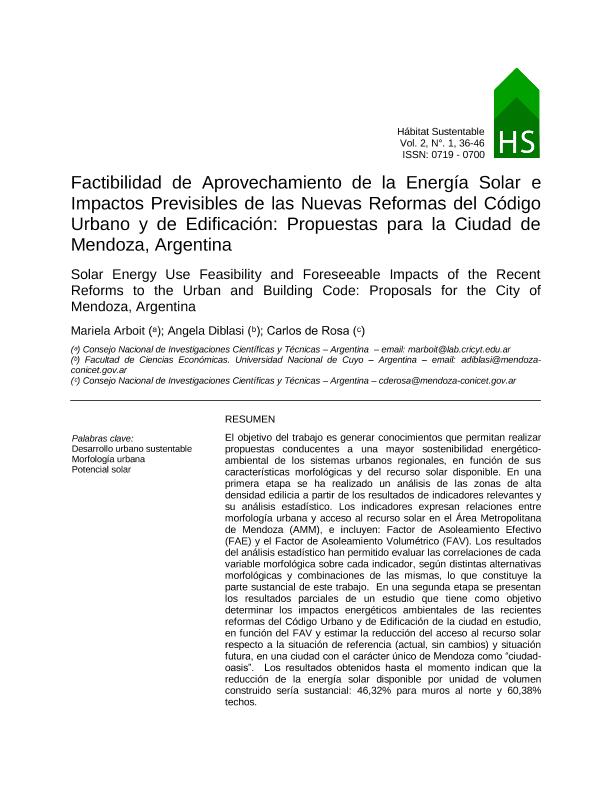Artículo
El objetivo del trabajo es generar conocimientos que permitan realizar propuestas conducentes a una mayor sostenibilidad energéticoambiental de los sistemas urbanos regionales, en función de sus características morfológicas y del recurso solar disponible. En una primera etapa se ha realizado un análisis de las zonas de alta densidad edilicia a partir de los resultados de indicadores relevantes y su análisis estadístico. Los indicadores expresan relaciones entre morfología urbana y acceso al recurso solar en el Área Metropolitana de Mendoza (AMM), e incluyen: Factor de Asoleamiento Efectivo (FAE) y el Factor de Asoleamiento Volumétrico (FAV). Los resultados del análisis estadístico han permitido evaluar las correlaciones de cada variable morfológica sobre cada indicador, según distintas alternativas morfológicas y combinaciones de las mismas, lo que constituye la parte sustancial de este trabajo. En una segunda etapa se presentan los resultados parciales de un estudio que tiene como objetivo determinar los impactos energéticos ambientales de las recientes reformas del Código Urbano y de Edificación de la ciudad en estudio, en función del FAV y estimar la reducción del acceso al recurso solar respecto a la situación de referencia (actual, sin cambios) y situación futura, en una ciudad con el carácter único de Mendoza como “ciudadoasis”. Los resultados obtenidos hasta el momento indican que la reducción de la energía solar disponible por unidad de volumen construido sería sustancial: 46,32% para muros al norte y 60,38% techos. The aim of this study is to generate knowledge that allows proposing actions leading to greater measures of energy and environmental sustainability of the regional urban systems, as a function of their morphologic features and available solar resources. On the first stage, the work has concentrated on the analysis of urban zones of high density, considering the results obtained by the use of relevant solar energy indicators and the implementation of statistical analysis. The indicators show relationships between urban morphology and access to solar resources in Mendoza’s Metropolitan Area. They include: Effective Insolation Factor (FAE) and Volumetric Insolation Factor (FAV). The results from the statistical analysis have allowed evaluating the relative weight of each morphologic variable on each indicator, in different morphologic alternatives and their combinations, which is the substantial part of this research. On the second stage, the preliminary results of a study are presented. It is aimed at determining the adverse environmental and energy consequences of implementing Mendoza’s Municipality recently modified Urban and Building Code, with a function of FAV and the solar access reduction estimation from the reference situation (present without changes) and the future situation, on mid and long terms evolution of Mendoza’s unique character, internationally recognized as a valuable example of an “oasis city”, which should be presented. So far, the results indicate that the reductions of the available solar energy per unit of built volume, are substantial: 46,32% for north facing walls and 60,38% for roofs.
Factibilidad de aprovechamiento de la energía solar e impactos previsibles de las nuevas reformas del Código Urbano y de Edificación: Propuestas para la ciudad de Mendoza, Argentina
Título:
Solar energy use feasibility and foreseeable impacts of the recent reforms to the Urban and Building Code: Proposals for the city of Mendoza, Argentina
Fecha de publicación:
06/2012
Editorial:
Universidad del Bío-Bío
Revista:
Hábitat Sustentable
ISSN:
0719-0700
Idioma:
Español
Tipo de recurso:
Artículo publicado
Clasificación temática:
Resumen
Archivos asociados
Licencia
Identificadores
Colecciones
Articulos(INCIHUSA)
Articulos de INST. DE CS. HUMANAS, SOC. Y AMBIENTALES
Articulos de INST. DE CS. HUMANAS, SOC. Y AMBIENTALES
Citación
Arboit, Mariela Edith; Diblasi, Angela Magdalena; de Rosa, Carlos; Factibilidad de aprovechamiento de la energía solar e impactos previsibles de las nuevas reformas del Código Urbano y de Edificación: Propuestas para la ciudad de
Mendoza, Argentina; Universidad del Bío-Bío; Hábitat Sustentable; 2; 1; 6-2012; 36-46
Compartir




